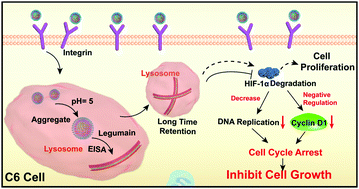Dual-responsive self-assembly in lysosomes enables cell cycle arrest for locking glioma cell growth†
Abstract
Herein we first report a dual-responsive peptide substrate (Comp. 1) for preparing self-assembled nanomaterials triggered by pH and legumain. The dual-responsive self-assembly of Comp. 1 in glioma cells enables its long retention time in lysosomes, S phase arrest, and cell growth locking. We verified that the blocked degradation of HIF-1α in lysosomes played a key role in cell cycle arrest and decreased DNA replication. This work illustrates the disturbance of lysosomal function by self-assembled nanomaterials as a promising strategy for inhibiting glioma cell growth.



 Please wait while we load your content...
Please wait while we load your content...